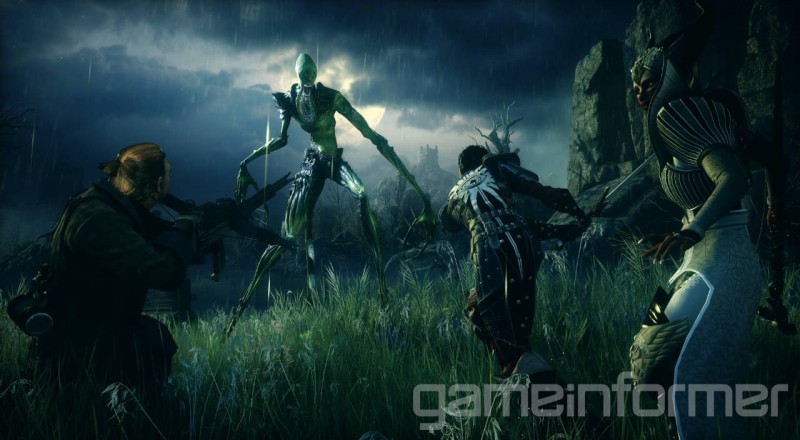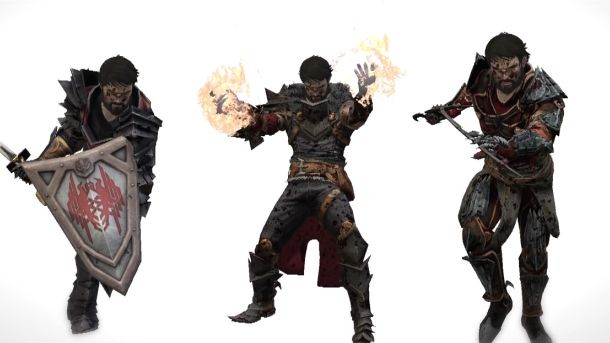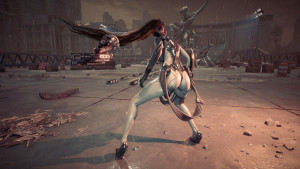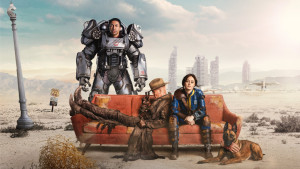Please support Game Informer. Print magazine subscriptions are less than $2 per issue
Creating Dragon Age Party Members

You wouldn’t make it through your journey and the world would likely end up in shambles without the brave souls that join your cause. Your followers are the heart and soul of the Dragon Age experience. Love them or loathe them, you’re unlikely to forget about them.
BioWare has created stand-out party members throughout the Dragon Age series, whether it’s Morrigan and Alistair bickering or Varric’s ridiculous stories; your party becomes your family. What goes into the creative process behind the allies that are going to be there every step of the way? What can we expect from Dragon Age: Inquisition’s cast? We couldn’t resist asking BioWare these questions on our recent visit.
Starting Points

Believe it or not, before a character is even written, the process starts with a concept artist. Writers merely provide a blurb for a character; something as succinct as, "Dexter-meets-Madame Butterfly" to the concept artist. “We’ve found that if the writers forged on ahead and created these fully-fleshed characters that by the time it got the concept artist, the concept artist might be like, ‘No, [I] don’t understand, and they’ll be playing catch up the whole time,’” says lead writer David Gaider.
By involving the artists early on, the process becomes more collaborative. The concept artist then takes the initial vision and provides a few ideas, “Elaborating on [the blurbs] and trying different directions – because when it’s early nothing is set in stone or fluid, you can try different stuff,” says associate art director Matt Rhodes. “In our heads, those different blurbs tell different stories. We put them on paper and then [the writer] picks them up, flourishes off of those, and eventually we start whittling them down to the ones that really work and stuck with people.”
BioWare has seen firsthand the benefits of this approach as it’s complemented the writers’ creativity well. “They provide some visuals for us and that would inspire us in turn, so we’re kind of building something together,” Gaider says. “I’ve rewritten scenes based on storyboards. I’ve described the story one way, the picture comes back, and I go, 'That’s completely different, that’s way better,'” says senior writer Luke Kristjanson.
Getting Down The Look

As they progress, the descriptions get more elaborate, giving the artists more to consider with the design. For instance, a coat can say something about a character’s history, and as most know, BioWare is infamous for hiding trinkets to tell stories. “We always love hiding stuff on a character, like really big important things that are huge aspects of [them],” Rhodes says. “We love hiding them somewhere, having some trinkets so when the revelation hits, you’re like, ‘That’s what this has been this whole time!’ But we need to reign ourselves in. Sometimes there are things that are too big and we can’t put it right there on the surface or it ruins the whole art.”
Too many hands on deck when creating such a personality can be difficult, so the team makes sure they have the best interest of the character in mind. “There’s a delicate balance that we all walk where a character has to have their own identity, have their own selves,” Rhodes says. “When too many of us make too many decisions about that character that are apparent…they can tend to get kind of sandblasted down; trying to make sure the characters are given their own identity physically and story-wise is critical.” Rhodes points out how in the past, the main distinguishable parts of characters were the costume design and affectations.
Rhodes noticed when studying fan art that people were always changing the characters’ faces and moods around. “This time we’re pushing toward having a character be [more] recognizable,” Rhodes says. “If someone’s going to draw them, they have to draw the bump in their nose because that’s a part of who they are. You might not think that’s attractive, but that’s okay. Do you think every part of your friends or loved ones are attractive? It’s part of growing to like somebody for all of their quirks.”
After all the design work is said and done, BioWare prefers to have a realistic character over the embodiment of perfection. Still, showing a character – flaws and all— to the world can be nerve-wracking. “I have those feelings sometimes where I don’t want to send my kid to his first day of school wearing a propeller hat, you know?” Gaider says.
Up Next: Deciding on party members and changing characters to balance out the group...
Constructing The Party

Deciding on a cast can be tough, but after the concept artist and writer find what works best, the next stop is to step into deeper waters. “[We] look at the major themes of the game and decide high-level questions we want to ask our players,” says creative director Mike Laidlaw. “The party is one of the core vehicles that help us to pose those questions, because they’re near and they have reactions and you kind of naturally gravitate.”
The point isn’t to make a character a mere issue, but instead give the player insight into why someone would side with a certain view. “Party members allow us to humanize the issues, to distill it down to one person who can present it in an emotional manner,” Gaider says.
This came into play with the creation of Dragon Age: Inquisition party member Vivienne. This circle mage was in line to be first enchanter in the Circle of Oralis before the mages declared their independence and broke away from the Chantry. “That is a character who has a very specific view on the role of the circles and the Chantry,” Kristjanson says. “As someone who is extremely pro-circle, what is left for that person when that entire system crumbles? [She’s] going to want a very particular thing from the inquisition depending on the way you’re headed that may or may not match with [your] Inquisitor.” These issues are meant to tear you between the party members you’ve grown to love. “I may not care about the Mages, but I may care about Vivienne,” Laidlaw says.
Another meeting the BioWare team has is to make your party interactions not just about an agenda, but to build a party dynamic. “[We] decide, ‘What does this character think of all the others? What do they banter about? And do they even like each other?’” Kristjanson says. “And that illustrates the main themes of the game even more. Sometimes in surprising ways because, maybe [you would think] that two characters would obviously hate each other, but maybe they don’t. Maybe those two liking each other says something even bigger about the games or themes in play." Laidlaw adds, "Or them growing to like one another. That’s essentially Isabela and Aveline.”
The BioWare team also addresses bringing back characters from previous games. That was no different with Inquisition and they had high hopes for many, but it’s important that the returning characters make sense. “[It] changed a lot and we finally decided, ‘No. We’d just love to have [a particular] character, but we just can’t,’” Laidlaw says. So far BioWare has announced that Morrigan is returning, but Varric and Cassandra are the only returning characters confirmed as party members. “They’re the other approach. We have to ask ourselves, ‘How did they grow?’” Laidlaw says. "'How did they change in the intervening years? Why are Cassandra and Varric apparently [traveling] together; don’t they hate each other?'"
Changing Characters And Misconceptions

A party member is never set in stone, however, and often during development the needs of the story change. For instance, would you believe that Varric was originally written very different from the wisecracking, loyal guy that was presented in Dragon Age II? “At the beginning he was supposed to be an untrustworthy guy. The sleazy, slimeball….,” Gaider says. But as development went on, the writers realized they needed a character that stood up for you with all the opposing personalities in the party. “He just eased into the place that he was needed,” Gaider adds. “We’re not afraid to take a bomb to a character if he or she was kind of filling this role, and as the party has evolved, it’s drifted,” Laidlaw says “We’re not going to nuke the character, but we might rewrite [them].”
One of the biggest misconceptions that players have is that BioWare wants them to like all the party members. Players often feel like they’re doing something wrong if they can’t get everyone’s approval rating up. “We don’t put everyone in the party so you can like them all,” Kristjanson says. “Some people get very, very concerned about, ‘How do I make all these people like me?’ Well, that’s part of it, but part of it is also you making the decisions you want to make and suffering the weight of those decisions, even in the people closest to you.”
Even the writers who work so passionately creating the characters aren’t offended if you don’t like their character. When talking to David Gaider about Morrigan’s creation, he was quick to say he doesn’t try to go down that road and that predicting who fans are going to like is near impossible. “I didn’t think about it much because I didn’t care if anyone liked her,” Gaider says. “It’s a certain kind of freedom when you don’t have to worry about making a character likeable because that’s a hard thing to sell.” Kristjanson agrees. “Hate is fine; it’s indifference that’s the killer,” he says.
For now, we know that Vivienne, Varric, and Cassandra are along for the ride, but we can’t wait to see what other characters BioWare has in store to accompany us on our road as Inquisitor. Even if some of them may rub us the wrong way...











